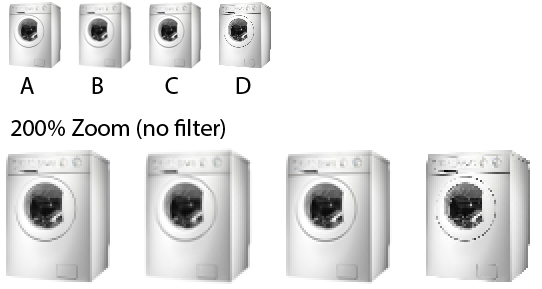In the script it is going from around the 300x300 mark down to 60x60. Need to improve the overall image quality as it is coming out very poorly at the moment.
public static Boolean resizeImage(String sourceImg, String destImg, Integer Width, Integer Height, Integer whiteSpaceAmount)
{
BufferedImage origImage;
try
{
origImage = ImageIO.read(new File(sourceImg));
int type = origImage.getType() == 0? BufferedImage.TYPE_INT_ARGB : origImage.getType();
int fHeight = Height;
int fWidth = Width;
int whiteSpace = Height + whiteSpaceAmount; //Formatting all to squares so don't need two whiteSpace calcs..
double aspectRatio;
//Work out the resized dimensions
if (origImage.getHeight() > origImage.getWidth()) //If the pictures height is greater than the width then scale appropriately.
{
fHeight = Height; //Set the height to 60 as it is the biggest side.
aspectRatio = (double)origImage.getWidth() / (double)origImage.getHeight(); //Get the aspect ratio of the picture.
fWidth = (int)Math.round(Width * aspectRatio); //Sets the width as created via the aspect ratio.
}
else if (origImage.getHeight() < origImage.getWidth()) //If the pictures width is greater than the height scale appropriately.
{
fWidth = Width; //Set the height to 60 as it is the biggest side.
aspectRatio = (double)origImage.getHeight() / (double)origImage.getWidth(); //Get the aspect ratio of the picture.
fHeight = (int)Math.round(Height * aspectRatio); //Sets the height as created via the aspect ratio.
}
int extraHeight = whiteSpace - fHeight;
int extraWidth = whiteSpace - fWidth;
BufferedImage resizedImage = new BufferedImage(whiteSpace, whiteSpace, type);
Graphics2D g = resizedImage.createGraphics();
g.setColor(Color.white);
g.fillRect(0, 0, whiteSpace, whiteSpace);
g.setComposite(AlphaComposite.Src);
g.setRenderingHint(RenderingHints.KEY_INTERPOLATION, RenderingHints.VALUE_INTERPOLATION_BILINEAR);
g.setRenderingHint(RenderingHints.KEY_RENDERING, RenderingHints.VALUE_RENDER_QUALITY);
g.setRenderingHint(RenderingHints.KEY_ANTIALIASING, RenderingHints.VALUE_ANTIALIAS_ON);
g.drawImage(origImage, extraWidth/2, extraHeight/2, fWidth, fHeight, null);
g.dispose();
ImageIO.write(resizedImage, "jpg", new File(destImg));
}
catch (IOException ex)
{
return false;
}
return true;
}
Really just need to know if their is something I can plug in that will bump up the quality or if I need to look at something else entirely.
EDIT: Picture comparison.
Source, just picked a random washing machine from google. http://www.essexappliances.co.uk/images/categories/washing-machine.jpg

The same picture converted in Photoshop to what I need it to be. https://i.sstatic.net/Nn6S0.jpg

What it looks like being converted like this. https://i.sstatic.net/uXZMD.jpg







VALUE_INTERPOLATION_BICUBICinstead ofVALUE_INTERPOLATION_BILINEAR? According to the documentation bilinear only considers a 4x4 sample from the input while it's less specific about bicubic. Proper resizing requires a larger sampling window as the ratio of output to input gets smaller. – Ahmad